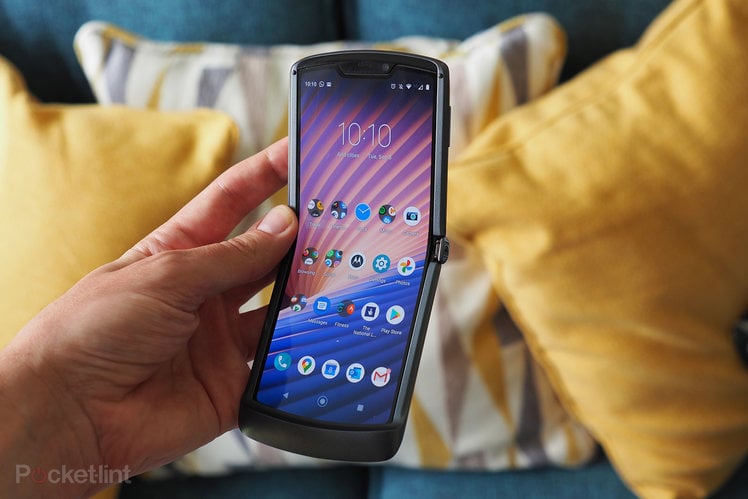
When the Motorola Razr burst back onto the scene in 2019 – some 15 years after the original – we were enamoured by the iconic clamshell in its new-fangled form.
Now the Razr is back once more, in second-gen 5G form, making inroads to improve some of its predecessor’s shortcomings – limited battery life, ‘crunchy’ screen unfolding sounds, second display functionality, so-so cameras, among other things – that its customer base had been highlighting to Motorola since launch.
At a glance the new Razr isn’t radically different, it’s more akin to a polished-up version of the 2019 model – and, perhaps, closer to what that major launch device should have been from the get-go.
With folding phones now a much bigger deal – there’s the imminent LG Wing, the Samsung Flip Z 2, among others – does the Motorola Razr 5G cut through the pack to jostle for its place as the flip phone king of 2020?
Why would you want a flip phone?
- Foldable clamshell design with patented ‘zero gap hinge’ mechanism
- Folded: 72.6 x 91.7 x 16mm / Unfolded: 72.6 x 169.2 x 7.9mm
- Weight: 192g
First up, a little refresher on what the Motorola Razr is all about. If you think about any smartphone you’ve had in your pocket over the last decade, it’ll most likely be a single-screen solution. But over the years such devices’ dimensions, on account of larger screens, have enlarged to sometimes mammoth proportions.
Enter the idea of flexible displays to deliver a bigger screen experience from a smaller form factor. The Razr is essentially a half-size clamshell phone which flips into fully formed device. As it uses a POLED display (that’s ‘plastic OLED’) there’s no need for two screens on the interior: it’s one internal panel that’s flexible and folds down the centre without leaving much of a crease.
Unlike the other flexible display devices, the Razr uses a stainless steel frame and a proprietary hinge mechanism – called a ‘zero gap hinge’, which comes complete with its own patent – that sees moving plates slide into place behind the screen, maintaining rigidity and form. It does a good job, too, although it’s not perfectly smooth – as we’ve felt when running fingers over it.
The Razr doesn’t just offer the one screen, though, as there’s the Quick View display on the front of the device. In the 2019 phone this was used for at-a-glance notifications and some interactions. The 2020 Razr steps things up here by opening to door to a much fuller suite of apps – they’re not officially compatible, but the software does warn you when that’s the case, and even then we’ve found having a mini WhatsApp, as one example, to be really useful.
Just like with the 2005 original, the modern Razr’s design means you can answer a call by flipping the phone open, or expand upon the Quick View display’s already open app/notification to expand across the full main screen.
However, do you really need a small exterior display to your phone? We’ve been mulling this over since using the Razr and – while our Quick View display use has definitely increased – many users will already have, say, a wearable (from Apple Watch to Fossil Gen 5) – and then jump over to their phone as needed, meaning two devices could be a more elegant solution for some.
Furthermore when it comes to unfolding the Razr we still don’t find it’s a one-handed use case. It’s a touch fiddly and, well, risky to try and throw open a pricey phone such as this. With two hands, however, you’ll probably open the Razr’s screen an almost annoying number of times to satisfy and itch you didn’t know you hand (good job it’s tested to 200,000 cycles then, eh?)
As we said of the 2019 model: “sure, there’s some nostalgic appeal to such a design, but it’s not a form factor that exists solely for that reason. This is a design that’s functional, that stands out, that feels different”. That’s a big part of the reason you’d want a Razr 5G: to turn heads, to make conversation, to be one of those who thinks differently.
The flip phone is back and better than before
- Finishes: Polished Graphite, Liquid Mercury, Blush Gold
- Stainless steel and glass construction
- Fingerprint scanner moved to rear
- Water repellent (not IP rated)
But the Motorola Razr 5G – or just Razr (2020) as the USA will be calling it – is a definite step forward over its 2019 predecessor. At a glance you might not spot a huge number of differences, but there’s plenty to point out.
| collection: | Razr 2 folding |
The biggest of the lot is the repositioning of the optical fingerprint scanner: it’s moved from the front (in folded form) to the rear (in either folded or unfolded form) to make it more readily accessible. Great idea, except it’s really low down for a fingerprint sensor position. Over our week of use our finger has naturally drifted downwards to adjust for this, but it still doesn’t feel right.
A better solution, we think, would have been to put the sensor under the Quick View display instead, as that’s easily reachable once the Razr is unfolded; plus it’d be useful to have a quick thumb-based unlock when the folded phone is sat on your desk and the rear scanner then hidden. Here’s hoping for that in round three.
As a result of the fingerprint scanner’s position the 2020 Razr’s ‘chin’ is more tapered than before, making for a neater looking device in its closed form. The new camera – which we’ll touch upon later – also looks far neater and more integrated.
There are material changes too. The 2020 Razr – which comes in three finishes (Polished Graphite, Liquid Mercury, Blush Gold) – has done away with the textured rear of the 2019 model, replacing it with glass. It’s befitting of the overall design aesthetic. That zero gap hinge is also less visible in closed form, thanks to more extensive covering. Oh, and the hinge doesn’t make a sound when you open the latest device – we’ve been keeping a keen ear out to ensure there are no scrunching sounds audible.
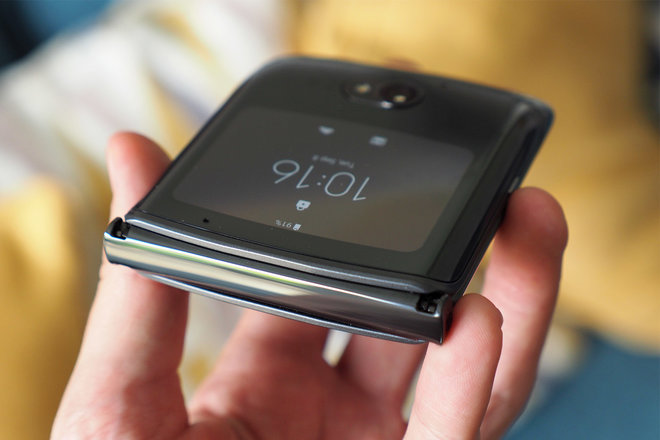
Another key take-away from the 5G Razr is the SIM tray to the bottom. Not unusual in a phone, sure, but the 2019 model was eSIM only, while the 2020 model is dual SIM – well, in the sense it offers capacity for a physical SIM and/or eSIM – this time around.
Although we don’t think people will notice, the second-gen Razr is also a couple of millimetres thicker than the 2019 model too. It makes the device a bit of a lump when folded, but it’s small, light and cute enough to not be of pocketable bother. Besides, a whisker of extra thickness means more room for battery capacity.
Are two screens better than one?
- Main screen: 6.2-inch POLED (plastic OLED)
- 2142 x 876 pixels, 21:9 aspect ratio
- Front screen: 2.7-inch GOLED (glass OLED)
- 800 x 600 pixels, 4:3 aspect ratio
The Motorola Razr 5G has the very same screen setup in 2020 as the 2019 model. No changes in size, resolution or materials to be found here.
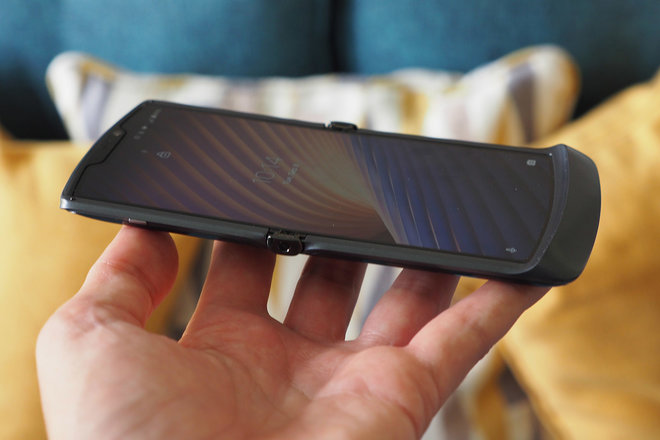
That means there’s still some of the inherent issues present: as POLED is plastic coated it’s reflective. You might not notice much in the winter, but in the late summer sun (as little of that as we’ve seen in the UK) it highlights any fingerprint smears and catches reflections to excess. That means the Razr isn’t the best when using it outdoors.
The 6.2-inch main panel itself is otherwise quick to activate upon opening, of ample brightness, and the resolution doesn’t have the impression of seeming as low as it reads on paper. No, there’s not as many pixels as many flagships, and no presence of faster refresh-rate here, but those kind of benefits are reserved for more conventional phones.
The 21:9 aspect ratio does make this panel feel a little slimmer than many of the hulking great flagship phones we’ve been handling of late. To that point that typing on the screen felt like it had been shrunk a little – something that didn’t take too long to adapt for.
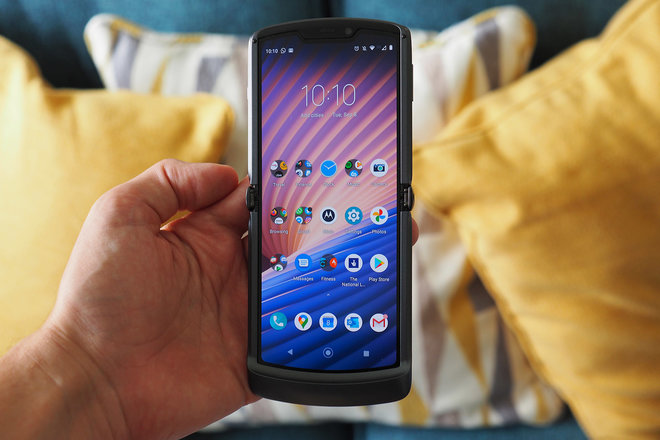
Besides, small keyboards are a theme of the Razr. The 2.7-inch Quick View display makes sure of that, as in the 2020 model it’s a largely functional panel that goes the extra mile compared to the 2019 model. As this is glass topped it’s less reflective than the plastic, but the glass still picks up a lot of fingerprints.
But back to the Quick View functionality. A software push means this second panel now offers a notification bar, so you can see which apps have notifications waiting. It’s possible to scroll through and dismiss these apps, or even – if you grant permission – allow the app to expand over the Quick View display if you don’t want to unfold the phone to expand the app to its fuller form.
You can even assign app shortcuts to your favourites, meaning once you’ve got, say, WhatsApp, Messenger, Gmail, Twitter and Slack all operational, you might only need to unfold the Razr to play a game or do some more heavy lifting. And Android 10’s gesture navigations work on this panel if you’ve moved on from the three softkey way of using Android.
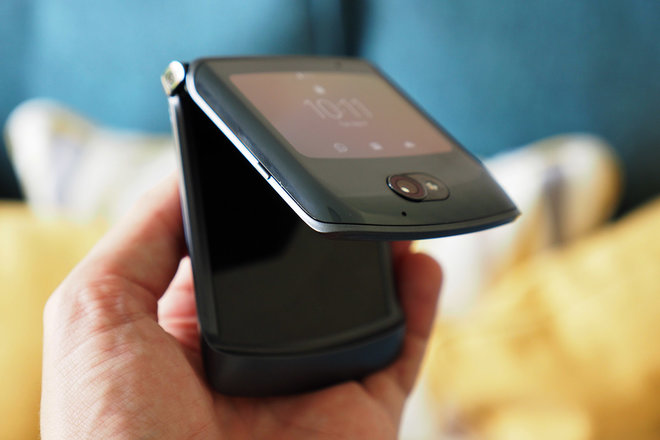
For all the Quick View display’s elegance, we do still keep coming back to that question: do you really need it (or a folding phone)? Maybe that’s a residing feature about the Razr: it had to ape the form-factor of the original to still be Razr, yet times have moved on in the way people interact with devices. We’re still on the fence, because as each day using the Razr 5G passes we do more and more with that exterior display, which makes us wonder if the question to ask is more whether we really need a conventional flagship phone instead.
Hardware: A 5G focus
- Qualcomm Snapdragon 765 processor, 8GB RAM
- 2800mAh battery, 15W TurboPower charging
- Adds SIM tray (original was eSIM only)
- 5G connectivity (sub-6GHz)
- 256GB storage
As the European name makes clear: this Razr has 5G connectivity. Fortunately it doesn’t add ‘the 5G tax’ that we’ve seen from so many other manufacturers. Not that this Razr is cheap: at £1,399/$1,399/€1,499 it’s no doubt a wallet-buster, but it is a full hundred of each of those local currencies less expensive than last year’s model (ignoring the third-off price drop that happened not so long back).
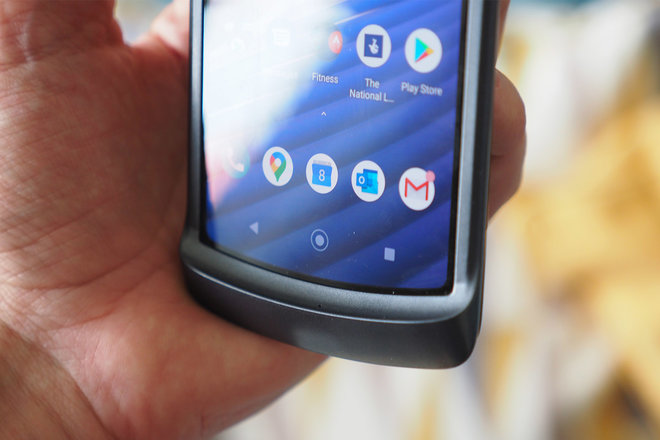
While we don’t have a 5G network anywhere near us – that’s one of the perils of 5G at present, as ubiquitous as it will become in the future – Motorola extensively detailed how the Razr has four antenna to ensure best signal in both folded and unfolded forms. It also covers a huge number of bands to ensure its operability internationally.
That connectivity requires a platform that permits it, which is where the Qualcomm Snapdragon 765 comes into play. Although it’s not the top-tier processor on the market right now, it’s totally befitting for it to appear in the Razr 5G because it’s less power intensive, less heat emitting, and that equates to more sensible battery life.
Because, to tell the truth, we’d anticipated the Razr 5G’s battery life wasn’t going to cut it. The 2,800mAh total capacity of the cells in this phone is so much less than what you’ll find in many flagships with 4,500mAh or more. But we’ve been proven wrong: the 2020 Razr has been running from full charge to around 40 per cent over 14 hours; pressed a little harder with more on-screen time and that’s more like 25 per cent remains after 12 hours. Still, it’s an acceptable amount – and probably beats the Samsung Galaxy Note 20 we had been using prior.
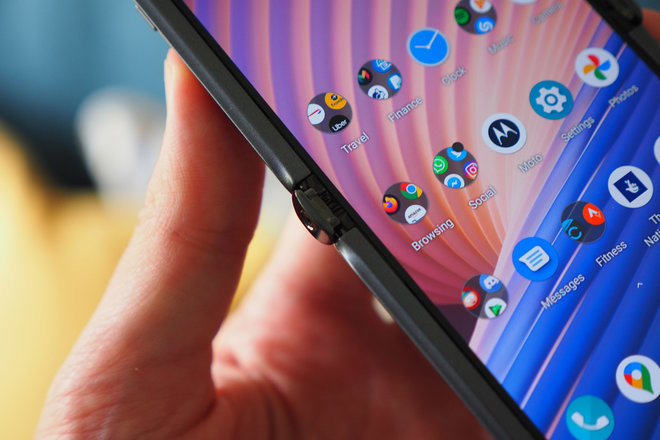
And it’s not as though the Razr does less than other phones. We’ve not noticed any problems with it cutting apps off when they’re running in the background. The frequently active display of the Quick View panel doesn’t delay with notifications and alerts. Without switching on the battery saver we’ve been able to play AAA games without issue, no lag, no stutter. The specs don’t read flagship, but as we’ve seen from so many Snapdragon 700 series devices, this level of capability will serve everyone bar those seeking a ‘gaming phone’ level we suspect.
Cameras: Raising the resolution
- 48MP main camera (flips for selfies too)
- Samsung GM1 sensor (1.6μm pixel size)
- Optical stabilisation (OIS)
- Laser autofocus
- f/1.7 aperture
- 20MP internal camera (for face unlock and attentive display)
On the cameras front – which is something we’ll return to and test more thoroughly before the 14 September full review embargo – it’s great to see that Motorola has upped the main sensor’s capabilities to be in line with current expectation.
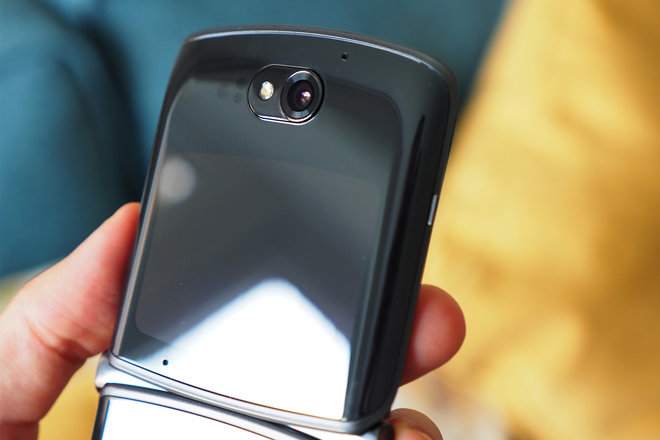
The 2019 model’s 16-megapixel sensor was paltry for the time, so the 2020 5G model’s inclusion of a 48-megapixel sensor – a Samsung GM1 sensor, no less – makes a lot more sense. It’s large scale, has proven quality from use in other Moto devices, and uses a four-in-one pixel processing technology – Motorola calls it Quad Pixel – to bring as much detail as possible.
There’s also optical image stabilisation (OIS) this time around, another feature that was sorely lacking from the last generation’s feature set.
And the internal camera’s resolution has also seen a jump – from 5MP to 20MP – to ensure better quality there too. Not that you’re especially likely to use that camera for selfies, as the external camera can handle that by simply flipping the phone around, making it a sort-of two-in-one solution.
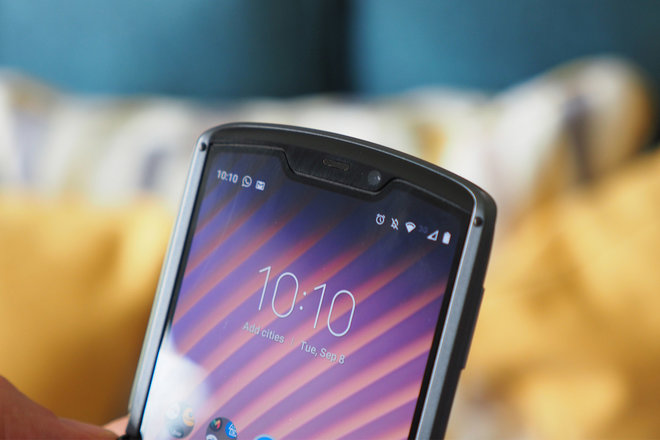
Ultimately the Razr still doesn’t offer the wider range of features that many current flagships offer – there’s no ultra-wide lens, no zoom lens – as that’s just not going to be feasible in this form factor.
